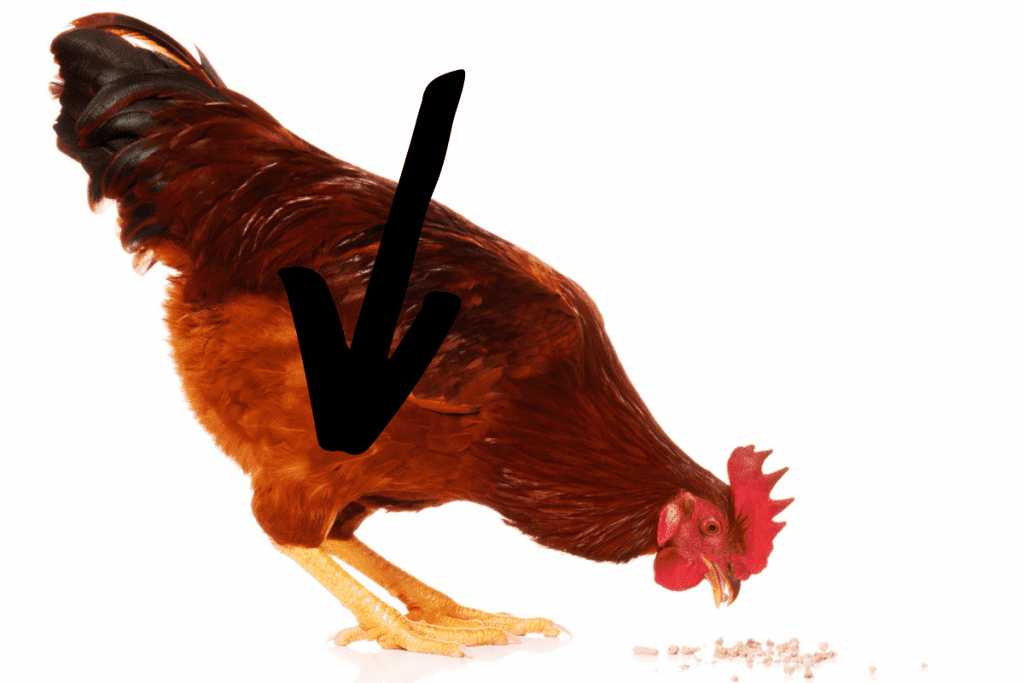If you’ve ever watched a chicken walk, it looks like its knees are pointing backward, making you wonder how they get anywhere.
What you’re looking at is their ankle, and it is not pointing backward if you stop to think about it.
Chickens have toes, feet, ankles, and knees like most animals, and they also have a backbone and legs. A chicken’s knee is the joint connecting the upper leg bone to the bottom part of the leg. The knee is up against their body, hidden by a covering of feathers and not visible when they are walking.
Chicken knees do have kneecaps!
Chickens keep their knee joint bent while standing at rest, which keeps them ready and able to move quickly.
For more on chicken’s knees and anatomy, read on!

Table of Contents
ToggleDo Chickens Have Kneecaps?
Chicken knees, like most birds, have patellae, otherwise known as kneecaps.
Kneecaps are unnecessary for the mechanics of walking but are protective and help with extension and movement.
Ostriches have the singular honor of having two patellas on each knee.
Two patellas might let the ostrich straighten its leg faster, which could enable it to run faster.
Their knees may not seem like ours in the traditional sense, but they still function similarly.
In fact, you’ll find this topic something of an issue up for debate.
Some people think the way chicken knees work is so different they don’t count.
Do Chickens Have Ankles?
Chickens have ankles just like humans, and other animals do.
Unlike the ankle in humans, a chicken’s foot only contains some of its ankle bones.
The joint you see halfway up the chicken’s leg is their ankle and has the rest of their ankle bones.
The bone from the ankle to the toes is actually what would be the instep in humans.
The upper leg bone, or femur, is also called the thigh bone.
The ankle looks like it’s bending backward on a chicken and other animals with a similar leg structure, such as cats.
Chicken ankles are called the hock joint and are a delicacy in some places.
Chicken hocks are mostly cartilage and skin but are supposed to taste similar to popcorn chicken.
Do Chickens Have Elbows?
Again, like humans, chickens have elbows.
What is an arm on a human is the wing of a chicken.
The elbow is the joint between the humerus and the radius/ulna in their wing.
A bird’s elbow allows movement to extend and fold the wing, not to move up and down.
Periodically, chickens will stretch a wing or a leg out straight to get comfortable.
This is nothing to worry about and is normal.
Do Chickens Have Teeth?
Chickens, like other birds, do not have teeth.
They still have the genes to make teeth; scientists can switch them back on, though!
Chickens use their beaks to peck at food and crush it into smaller pieces against the ground.
The chicken swallows the food down to its crop, an expanding pouch at the base of the neck.
Over the day, the chicken’s crop fills up only to be emptied overnight.
If your chicken’s crop doesn’t empty, there is a problem.
The food in the crop mixes with water and beneficial bacteria and begins the digestive process.
Sometimes there is an imbalance in the bacteria, and your chicken will develop a sour crop.
Prevent sour crop by providing probiotics such as yogurt or apple cider vinegar, fresh, clean water, and plenty of grit.
Once the food reaches the gizzard, it is ground up using small stones the chicken picked up during the day.
This is why having clean grit available is a must for your flock.
The gizzard contracts and churns the food, which is the “chewing” part, until it is small enough to pass through the small intestine, where nutrients are absorbed.
How Do Chickens Walk?
Humans bend at the knee to bring each foot forward when they walk.
A chicken knee is bent standing there, giving it balance and the ability to move quickly.
As chickens bring each foot forward, they bend their knee; the ankle bends and points back, while on the back leg, the knee straightens, and the chicken moves forward.
Their toes provide balance and grip.
As the chicken walks, it juts its head forward.
This bobbing of its head stabilizes its gaze as its body moves forward.
Read more: Chicken head bobbing and what it means
Like cats and owls, chickens have gyroscopic heads, which is fun to explore when holding your pet chicken.
Chickens keep their head stable even though their body is moving around.
This is part of the vestibulo-ocular reflex, which is a reflex where the head and eyes remain fixed on a point as long as it isn’t putting too much stress on the body.
Their body feels the force of changing their position and automatically rearranges their head’s position.
As a predator, this ability would make it easier to track prey.
They are also what is called digitigrade, which means they walk on their toes or digits.
Humans are plantigrade, which walk with their heels on the ground.
Deer, cows, horses, and other hooved animals are unguligrade, which means they walk on their toenails.
Chickens Have Three Toes Pointing Forward, Are They Dinosaurs?
In the animal kingdom, chickens are descended from a group of meat-eating, two-legged dinosaurs with three or fewer fingers called theropods.
A well-known theropod dinosaur, T-Rex, has its closest modern relatives in birds, which includes chickens.
It is safe to say chickens are related to dinosaurs, and less scientifically correct to call them a dinosaur.
Their toes may break too!
Check out our article on what to do if chickens break a toe.
How useful was this post?
Click on a star to rate it!
We are sorry that this post was not useful for you!
Let us improve this post!
Tell us how we can improve this post?
